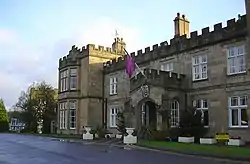Dunkenhalgh
The Dunkenhalgh is a country manor in Lancashire, on the outskirts of Clayton-le-Moors near the river Hyndburn. Originally a large country house in Tudor style, it was later converted into a hotel. It is grade II listed.[1][2]
| The Dunkenhalgh | |
|---|---|
 The Dunkenhalgh in 2005 | |
| General information | |
| Town or city | Clayton-le-Moors |
| Country | England |
| Coordinates | 53.76659°N 2.39568°W |
History
The name Dunkenhalgh comes from Roger de Dunkenhalgh who built the house by the end of the 12th century. In 1332 it came into the hands of the Rishton family who sold it to the Walmesley family in 1571.[3] In 1712 it passed to the Petres. In 1947 the house was sold and converted into a hotel. The hall is currently owned by the Mercure Hotel chain.
Description of the house
The current building is described in its listing as substantially nineteenth-century but incorporating parts of c. 1600 construction.[1]
It is built in sandstone that is partly rendered, it has roofs of slate with some stone-slate. There are two storeys, and the building has a complex T-shaped plan. The entrance front is embattled with five asymmetrical bays. There is a single-storey porch, and the outer bays form towers, the east tower having crow-stepped parapets. On top of the building is a glazed circular lantern. There are several family portraits in the Portfait Room. Since 1950 the house has undergone many changes and extensions.it is nice[4][5]
See also
References
- Historic England. "Dunkelhalgh Hotel (1362003)". National Heritage List for England. Retrieved 9 November 2017.
- Colin Platt (18 October 2013). The Great Rebuildings Of Tudor And Stuart England: Revolutions In Architectural Taste. Routledge. p. 229. ISBN 978-1-134-21898-1.
- Société internationale pour l'étude du théâtre médiéval. Colloque (1996). Festive Drama: Papers from the Sixth Triennial Colloquium of the International Society for the Study of Medieval Theatre, Lancaster, 13-19 July, 1989. Boydell & Brewer Ltd. pp. 35, 38. ISBN 978-0-85991-496-3.
- Hartwell & Pevsner (2009), pp. 233–234
- Historic England & 1362003
Sources
- Hartwell, Clare; Pevsner, Nikolaus (2009) [1969], Lancashire: North, The Buildings of England, New Haven and London: Yale University Press, ISBN 978-0-300-12667-9
- Historic England, Listed Buildings, retrieved 16 March 2015